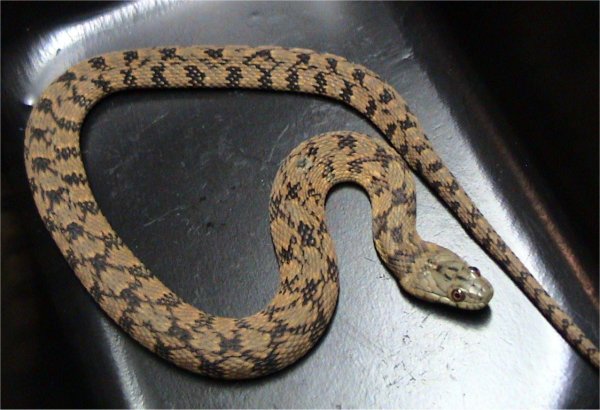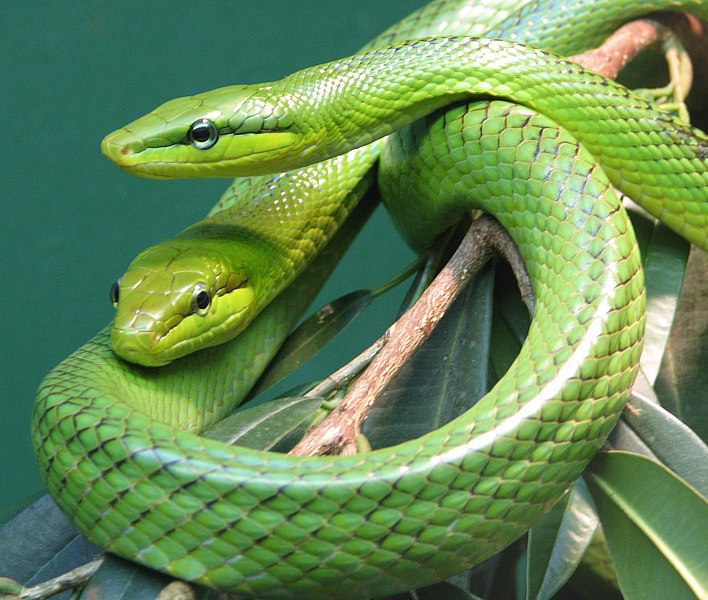Watersnakes are largely ignored by herptoculturists, and I’ve never quite understood why. Hardy, prolific, and often colorful, their utilization of two habitats makes for very interesting observations. Today I’d like to focus on the northern watersnake (Nerodia sipedon sipedon), and to mention a few others.
Description
 Background color varies through shades of pale gray to dark brown, with reddish to black cross-bands. Juveniles are brightly marked, while the colors of older animals usually darken. Stoutly built, the northern watersnake may reach 4 ½ feet in length, but averages 3 feet.This species interbreeds with its subspecies, the midland water snake, which may confuse identification at range overlaps.
Background color varies through shades of pale gray to dark brown, with reddish to black cross-bands. Juveniles are brightly marked, while the colors of older animals usually darken. Stoutly built, the northern watersnake may reach 4 ½ feet in length, but averages 3 feet.This species interbreeds with its subspecies, the midland water snake, which may confuse identification at range overlaps.
Range
The range extends from southeastern Quebec, Canada to North Carolina, Alabama and Mississippi. Related subspecies occur as far west as Colorado.
The endangered Lake Erie water snake (N. s. insularis), a subspecies of the northern, is found only along Put-In-Bay, Lake Erie.
Habitat
The northern water snake frequents swamps, ponds, lakes, rivers and streams. It rarely strays far from the water’s edge, but frequently basks on logs and overhanging branches. Although preferring quiet waters, I sometimes encounter them along swiftly flowing rivers.
Status in the Wild
 This snake can build up large populations in suitable habitat but, in my experience, does not adjust well to human presence (it is sometimes killed in the mistaken belief that it is venomous and reduces game fish numbers).
This snake can build up large populations in suitable habitat but, in my experience, does not adjust well to human presence (it is sometimes killed in the mistaken belief that it is venomous and reduces game fish numbers).
Several years ago I visited formerly well-populated ponds on Long Island, NY, as part of a government-sponsored survey. Despite adequate habitat and a healthy prey base, I found nearly all to be barren of snakes, and local fishermen confirmed their absence.
Diet
Watersnakes seem almost “crazed” when food is scented. Legendary reptile man Raymond Ditmars reported catching them on fishes tied to a string, a feat I repeated a half-century later with admirable results. I have also taken them in minnow traps.
Watersnakes feed upon a wide variety of frogs, tadpoles, salamanders and fishes and crayfishes.
Reproduction
Mating occurs in early spring. The young, 9-100 in number, are born alive after a gestation period of 2-3 months (March-July).
Miscellaneous
This snake was once common within NYC but has declined dramatically. I re-introduced it to the grounds of the Bronx Zoo in 1986, and a small breeding population is now to be found there.
Northern water snakes are harmless but aggressive when disturbed, and are often mistaken for the venomous water moccasin. The confusion is greatest in the Southeastern USA, a watersnake-lovers paradise, home to 12-15 subspecies. The massive Florida green water snake (N. floridana) reaches 6 feet in length and even holds its mouth open when threatened, in a manner reminiscent of the moccasin’s display.
Various watersnake species regularly hybridize, producing a bewildering array of forms in the species-rich southeast. Despite the passage of over 20 years, I still clearly recall a gorgeously-patterned individual that I narrowly missed capturing in south Florida. It was almost certainly a mangrove watersnake (N. clarkii compressicauda), perhaps hybridized with a Gulf salt marsh or Florida watersnake. I realize that my awe seems odd in these times of captive-bred “designer snakes”, but to encounter such a creature in the wild was quite a thrill.
Further Reading
You can learn more about the natural history of the 10 Nerodia species at http://www.jcvi.org/reptiles/search.php?submit=Search&exact%5B%5D=genus&genus=Nerodia.
Nerodia sipedon image referenced from Wikipedia and originally posted by Brian Gratwicke
Nerodia rhombifer image referenced from Wikipedia and originally posted by LA Dawson.
 That Reptile Blog – Reptile, Amphibian and Exotic Pet Care and Information
That Reptile Blog – Reptile, Amphibian and Exotic Pet Care and Information

 Red-tailed ratsnakes are best suited as exhibit animals. Most do not hesitate to bite when approached, and fight vigorously when restrained. Some may become moderately tame, but such individuals must be watched closely and not allowed in the vicinity if one’s face or near children (or, obviously, your parakeet!).
Red-tailed ratsnakes are best suited as exhibit animals. Most do not hesitate to bite when approached, and fight vigorously when restrained. Some may become moderately tame, but such individuals must be watched closely and not allowed in the vicinity if one’s face or near children (or, obviously, your parakeet!). Iridescent coloration is exhibited many snakes, but in none is it as spectacular as that featured by the rainbow boa (Epicrates cenchria cenchria). The “glow”, of its brilliant coloration, caused by microscopic scale ridges that refract sunlight, have long made this species a pet trade favorite.
Iridescent coloration is exhibited many snakes, but in none is it as spectacular as that featured by the rainbow boa (Epicrates cenchria cenchria). The “glow”, of its brilliant coloration, caused by microscopic scale ridges that refract sunlight, have long made this species a pet trade favorite. Most ball pythons take readily to pre-killed mice and small rats, with hatchlings usually being large enough to handle a “fuzzy” mouse. In the wild, ball pythons do not feed when nighttime temperatures become cool (January-February in some areas), during much of the breeding season, and while incubating eggs. They are well adapted to long fasts, and frequently go off-feed in captivity. This can occur even in captive-hatched animals, tuned, perhaps, to an internally-controlled cycle, and is rarely a cause for concern.
Most ball pythons take readily to pre-killed mice and small rats, with hatchlings usually being large enough to handle a “fuzzy” mouse. In the wild, ball pythons do not feed when nighttime temperatures become cool (January-February in some areas), during much of the breeding season, and while incubating eggs. They are well adapted to long fasts, and frequently go off-feed in captivity. This can occur even in captive-hatched animals, tuned, perhaps, to an internally-controlled cycle, and is rarely a cause for concern. Only snakes in good body weight should be used for breeding purposes. Success will be more likely if the male and female are housed separately outside of the breeding season.
Only snakes in good body weight should be used for breeding purposes. Success will be more likely if the male and female are housed separately outside of the breeding season.